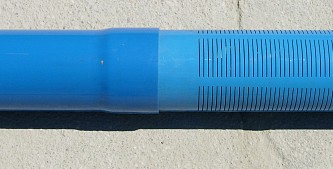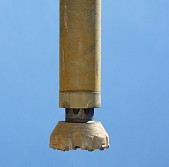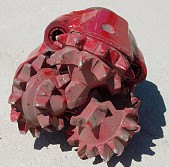| Water can be extracted by means of well digging or well drilling. When digging, well segments with a diameter of 1 to 3 meters are needed. These wells can be dug by excavator up to a depth of 6 to 8 meters. For larger depths the well is established by drilling. | |
| Wells for drinking water and wells for process water | |
| Well and geothermal drillings Ltd. is able to carry out well drillings up to 320 mm diameter (stabilizing pipework) and with a well construction (food safe synthetic material or highgrade steel) up to 200 mm diameter.
These drilling diameters are applied for the construction of wells for public water supply facilities, agricultural irrigation wells and larger geothermal heating facilities. For small water supply facilities, garden irrigation facilities and the like, drillings (stabilizing pipework 320 mm) with a drilling diameter of 240 mm (down-the-hole hammer, rolling bit, drag bit) are conducted. Subsequently the borehole is stabilized according to the desired water consumption with food safe synthetic material or highgrade steel.  
water gauge measuring wells: |
|
| The company is able to apply 3 different drilling techniques – according to the geologic situation: | |
| Down- the-hole hammer drilling: | |
| This Type of drilling is necessary,
if the subsoil consists of very hard Material, such as rock. The drill hammer, which crushes the hard material,
is powered by compressed air. 24m3 air per minute and 15 to 20 bar are required.
Our air compressors are powered by a diesel engine with a capacity of 365 and 390 PS or 270 and 287 KW.
The drilling debris is carried to the surface by air. If the material is too dry and generates dust,
we add water respectively a mixture of water and foam to prevent the dust generation.
|
|
| Rolling bit drilling: | |
| this drilling technique is applied in areas with sandy material or silty marl (Schlier). The removal of the drilling debris is the same as explained under down-the-hole hammer drilling.
|
|
| Drag bit drilling: | |
| this drilling technique is applied in areas with clay. The removal of the drilling debris is the same as explained under down-the-hole hammer drilling.
|
|
| Stabilizing Pipework: steelcasing | |
| At the beginning of the drilling process, the implementation of a stabilizing pipework is obligatory, so that drillings with the different drilling techniques can be started. Furthermore a stabilizing pipework is obligatory in areas where sandy material, gravel or detritus is present. These types of material can reach into greater depths, so that one diameter of pipework is not sufficient, because the frictional resistance between the pipe and the soil is too big. If this is the case, a telescope technique has to be applied: the drilling is started with a stabilizing pipework of 275 mm diameter and can be driven forth up to a depth of 25 meters. Subsequently the frictional resistance is so big, that deeper boring isn’t possible anymore because of the danger of twist off. In Order to increase the depth, a so called telescope piping with a smaller diameter is installed. A pipework of 219 mm diameter is assembled in the pipe with the diameter of 275 mm. The stabilizing pipework thus is able to allow a drilling of more than 25 meters. |  |
| Well finishing | |
| The well finishing takes place with original STÜWA well pipes and complete pipes with corresponding dimensions. | |

 |
|
| Example: Well drilling and finishing with a depth of 50 meters: After the drilling is completed, the drilling rod including the down-the-hole hammer or the rolling bit or the drag bit is completely removed from the borehole. Subsequently the well finishing is prepared as follows and installed: The well finishing is always prepared from bottom up to the site top edge. 1. from 50 to 49 meters the so called bottom sump is located with a bottom cap screwed on it. 2. adjoining the well filter pipes, with oblique slots of 0,5 to 1,0 mm according to the water-bearing stratum with a minimum length of 4 m are screwed to the bottom sump 3. Adjoining threaded complete pipes are used which lead to the top site edge. The ending of the pipe string is a well head. |
|


| |

|
|
| 4. Starting from the end of the gravel aggregate filter in addition to the screw connections a seal is inserted, in order to prevent potentially contaminated surface water from seeping into the well. |  |
| Disinfection | |
| Starting with the beginning of the well construction an approved disinfectant for drinking water wells is applied in order to extinguish potential intestinal germs immediately. | |
| Insertion of gravel into the annulus, | |
| The annulus is the space between the casing and the surrounding geological formation. The annulus is filled with washed gravel – grain size 4 to 8 mm – this filling has to include only one aquiferous stratus. | |
| Clay Seals | |
| In order to prevent an intermingling of aquiferous strata, so called clay seals are implemented. The clay seals are situated in non aquiferous strata, so that the quality of deeper groundwater or well water is not affected. The minimum height is 2 meters. The company uses only certificated clay materials such as Wetonit by STÜWA.
Back-filling of the remaining annulus An intermingling of water from different aquiferous strata is forbidden without exeption according to the Austrian law pertaining to water and waterways 1959. |

|
| Pumping for grit separation | |
| After the drilling is finished and the finishing is implemented a pumping for grit separation is executed in order to clean the borehole of all fine sandy materials. This is important to let the water appear "clear" and clean. | |
| Installation of the well shaft | |
| After the described works are finished, the well shaft is installed. The diameter of the well shaft is chosen according to the wishes of the customer. It is of importance that the well shaft is impermeable. The cover of the shaft has to be equipped with a ventilation pipe and a fly screen. It has to be rainwater proof. | |
| Well reborings | |
|
The company well and geothermal drillings Ltd. has an equipment of well drilling machines which allow the reboring of existing wells, if there is an economic rationality according to a hydrogeologic expert assessment or a prospection. In these kind of projects the above mentioned drilling techniques can be applied. When carrying out this type of projects, it is important that that the existing well is accessible by a truck of 17 tons or by a crawler drill of 21 tons and that there is enough space to mount the equipment. |
|
| Procedure of a well reboring | |
|
As already mentioned the well boring equipment is mounted above the existing well and the stabilizing pipework is turned down with the help of the rotary casing table until the pipe is stuck in the solid ground. Thus there is a high probability that a seal of the surface waters towards the subterranean waters exists. If it is the case that the existing well has been constructed with the help of blasting operations, there is a high probability that the soil formation in the underground and the surroundings of the well are disrupted. In such cases there is a danger that surface water can intrude also by loop way into the subjacent aquiferous strata. If the reboring has been carried out successfully, the same construction technique of finishing is applied as with new wells. However there is one difference, in an existing well the complete pipes including the sealing are hoisted freely and fixed in the upper part of the well. Finally an impermeable well head is installed on the pipe, containing openings for the underwater cable of a water-immersed pump |
|
| Construction of shaft wells (digging technique) | |
|
A shaft well is constructed by digging with an excavator or by hand. This type of construction is only feasible in areas with detritus, gravel or slip rock. If there are rock formations, they can be loosened by hydrocutter or by blasting operations and the material is excavated by earthmover or by hand with the help of a cable winch. If the aquiferous strata is reached, the well is constructed with well segments of minimum 1 meter inner diameter. In the aquiferous area outside the well segments the empty space is filled with washed gravel and covered by a fleece. Above the fleece a layer of clay is brought on in order to prevent the surface water from intruding unimpededly into the well.
The construction of such a well brings about a lot of material that has to be deposited later. If the well is not situated in an aquiclude, considerable fluctuation may occur regarding the intake. |
|
| Driven Wells | |
|
This type of well is only feasible in areas, where the subsoil consists of sandy material or gravel. A steel pipe with a cone end of 5/4“ to 2,0“ is stricken into the soil – either by hand or with the help of a compressor with a striking tool. Maximum depth is 8 meters. If this is completed, a well shaft is excavated, in which there is possibly room for a hydropneumatic pump and a controller.
Remark: With a hydropneumatic pump water can be drawn up to a maximum depth of 7 meters. If the groundwater is deeper, the water column collapses. |
|
| Installation of the appropriate water-immersed pump. | |
|
Basically a water-immersed pump with a flow rate should be installed which is of the same level as the intake at 1/3 to half drawdown. If it is the case that the intake is low ( 0,5 to 2 l/min) a probe controller has to be installed as a fuse for the pump. In order to guarantee a state of the art water supply, different controllers and diaphragm boilers of the appropriate size are necessary. |
|
| Services | |
|
Well and geothermal drillings Ltd. offers its services in the field of well construction and associated drilling techniques to public employers, farms, private households and industry. Well mechanized machines and equipment and an experienced team help to implement multifaceted projects |
|





